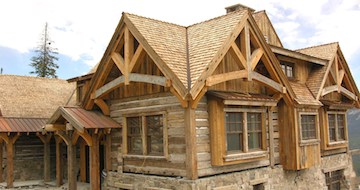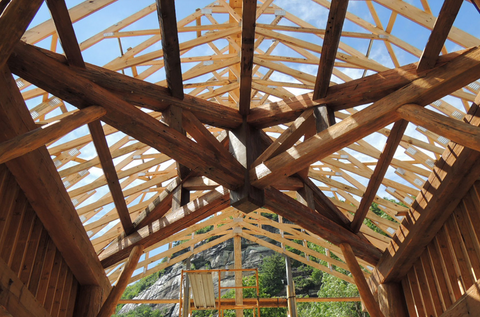Tough as timber
Timber framing stands the test of time
By DAVID REESE/Montana Living
The timber structures stand strong against the backdrop of the Montana prairie and mountains, their beams gray and weathered.

Photo courtesy Bitterroot Design Group
Having endured nearly a century of sun, wind, rain and snow, these log structures remain strong. Look closer, inside these barns and cabins, and you see why they have remained standing for so many years.
It is the art and craft of timber-frame joinery. As homesteaders were settling Montana territory in the mid 1800s, the art of timber frame construction made its way across the United States, from the east coast to the mountains and prairies of Montana.
For the last several years, the craftsmanship and beauty of timber framing are enjoying another resurgence in Montana as residents - the new Montana homesteader, perhaps - are seeking a strength, durability and attractive look that no other construction method offers.
From the magnificent homes and lodges in Big Sky and Whitefish, to renovations of middle-income homes in university towns, timber framing is being used in a wide range of applications in Montana.
For the last five years, Hasenour Woodworking in Whitefish has been helping build the stately lodges at Iron Horse, a private golf course and development on the hills overlooking Whitefish.
Greg Hasenour, a former cabinet maker, says working with age-old timbers brings an art and craft to construction that no other trade offers. His company works as a timber-frame subcontractor for Denman Construction in Whitefish. Between the two companies they helped build Elkhorn Lodge, a magnificent log structure at Iron Horse. "One of my favorite things about timber framing is being able to use that old wood," Hasenour says. "We're taking wood that's 100 years old and putting it somewhere it's going to hopefully stay for another 100 years."
The craft of timber framing is traced to the tools that the tradesmen use. While they do use high-powered electric saws and sanders, often the job comes down to simple hand tools like chisels and mallets. "It forces you to use these old tools," Hasenour says. "When you're creating a mortise, the only way you can get down in there is with a mallet and chisel."
Mortises, tenons, scissor cuts and splines are used to join and support pieces of wood, whether they're an 80-foot log truss or an eight-foot banister railing. The joinery in "true timber framing" uses no visible metal hardware. Construction that uses visible hardware is usually called post and beam.
However, hidden hardware is sometimes required in areas where seismic activity can occur. Using hidden hardware also reduces the cost of making hand-hewn joints. While timber framing is perfect for creating the lodge look in custom homes, it's also good for the back yard addition or remodel.
BIG TIMBER WORKS

Photo courtesy Big Timberworks
That's what Merle Adams, co-owner of Big Timberworks in Gallatin Gateway, did when he remodeled an old carriage house in an alley in Bozeman. South of Belgrade, on the way to Yellowstone National Park, the offices and construction yard of Big Timberworks lay sprawled out across several acres. It's common practice in timber framing to recycle timbers from old buildings, barns and other structures; behind the office of Big Timberworks is a log yard filled with timbers of all sizes, from grey, worn trusses, to peeled logs and branches. While the larger pieces will be used for supports, the character pieces will be used for railings or banisters.
There's even a tree stump that survived a forest fire. "We'll find somewhere to use that," Big Timberworks co-owner Tom Bowles said, nudging the stump with his boot. Big Timberworks began 18 years ago and is one of the oldest timber-frame companies in Montana. Big Timberworks and companies like it find old timbers where they can.
Recently a spate of old grain elevators being torn down in Saskatchewan, Canada, provided a good supply of thick, well-worn timbers. "We're really dependent on what's being torn down," Bowles said. They rely on brokers to alert them to pending demolitions where high-quality timbers might be found. "If any building is coming down, somebody finds out about it," he said.
BITTERROOT DESIGN GROUP

Photo courtesy Bitterroot Design Group
LONG KNOWN for its position in the log-home industry, the Bitterroot Valley is also home to one of the state's largest timber-frame designers and builders. Bitterroot Design Group saw the growth in the timber-frame industry and eight years ago built a 20-acre site near Stevensville, where log timbers are milled, carved and hewn for installation in homes across the country.
The company is building homes and timber-frame projects from Connecticut to Texas. Homes built by Bitterroot Design are assembled at the company's yard, taken apart and reassembled at the house's final destination.
Despite advances in timber frame milling, this is one area that simply can't be done at the homesite, Bitterroot Design's Jim Mauri said. Sophisticated equipment and machinery require that it be done at headquarters. "In the old days, they may have done it onsite, but unless you were passionate about doing that, it makes no economic sense," he said. Mauri said timber framing is growing in popularity not only in Montana, but in other areas of the United States where people want a rustic, well-worn look.
Bitterroot Design is building a timber-frame tower at a children's theatre in Minneapolis and is competing for the bid on a public zoo in Dallas. "I think America is in love with timbers," Mauri said. Being located in the heart of log-home country in the Bitterroot Valley, Mauri's business takes advantage of a capable, skilled labor force. The art of timber framing seems to intrigue people around the world. Mauri recently received an e-mail from an architect in England, who wants to come to Montana to work for them and learn timber framing.
"When they come to us, they're not just looking for a job," Mauri said. "The wood, and a return to the old techniques, really attract people. People come to us who have grown up in the business or are very interested in learning the craft. People who do it have to have a real interest and passion for the craft."
TIMBER FRAMING in the United States began in New England and migrated across the country as pioneers settled the West. Along the way, the art picked up a few modifications and is still evolving, says Tom Healy, a timber wright in Whitefish. Inside Healy's small timber-frame shop, wood shavings lie ankle deep in places, and the smell of fresh cut wood permeates the work place. Under the whistle and whine of electric drills, two men worked on timbers intently as Healy described his passion for timber framing.
"They're fun to design and go through the whole process," he said. "It makes you do some serious mental gymnastics." Healy is not only a timber framer, but he teaches the art too, at his Northhouse Folk School in northern Minnesota. The school teaches timber framing, boat building, weaving and spinning. Many of his students at his school are taking the timber-frame classes to learn how to build simple additions or do renovations on their own homes. "I like to make timber framing accessible not just to high-end trophy homes," he said.
However, Healy estimates that the price in Montana to build a 2,500 square foot home is around 25-75 percent more than a traditional "stick-built" house. Timber frame prices could come down as more people get into the business. Healy says a machine called a "hundegger" that can mill a timber on site might reduce the expense of having to ship new or recycled timbers to a job site. "It may make timber framing more accessible in the future," he says.
The art is still evolving, as more architects, designers and contractors are asked to build timber-frame homes. For people looking to build a timber-frame home, Healy recommends talking to a timber-frame shop before finding an architect. If the architect is not familiar with the intricacies of timber frame construction, "it can create problems," Healy said.
One thing has changed over the years as timber-framing evolved. While it used to take a community to raise a house, "now it takes a crane," Healy said.
This, he said, is much safer. "It's really fun (doing it the old way), but it takes a lot of human management." The work that these Montana companies are doing will likely endure the test of time. If time is the test, generations from now these timber-framed homes, barns and garages will still be standing on the Montana landscape. Some of the oldest timber frame structures in the United States date back to the 1600s.
"You get a unique look that only 100 years of weathering can produce," Hasenour says. "There's no way to duplicate it."
Healy, a teacher of the craft, agrees. "It strikes a balance between the rustic and the elegant." One of the biggest assets of timber framing is not in its longevity, but its looks. "Rather than hiding the structure in the walls and covering it up with drywall, we show the structure," Big Timberworks' Tom Bowles said. "That's a big value of a timber-frame structure - the esthetics."
Resources
On the Web
Timber Frame Guild: www.tfguild.org
Hasenour Woodworking: 250-9870
Big Timberworks: 406-763-4639 or www.bigtimbeworks.com
The Bitterroot Group: 995-7806 www.bitterrootgroup.com
Centennial Timber Frames: 406-755- 8114.




Leave a comment